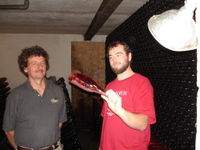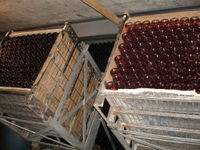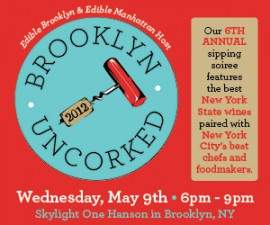Chateau Frank and the Economics of Bubbles
By Jason Feulner, Finger Lakes Correspondent
During a recent visit to Dr. Frank's to compile a profile of its sparkling wine operation for Life in the Finger Lakes, I learned more than I expected to about the hard economic realities of creating such wines in the Finger Lakes.
As nearly all Finger Lakes winemakers will profess, the region is well suited to making sparkling wine. Because of the cool climate, and a wide open harvest window, growers can let grapes hang just a little longer to enhance ripeness and flavor without sacrificing the crisp acidity necessary for good sparklers.
 Two of Dr. Frank's team winemakers who work with sparklers, Eric Bauman and Mark Veraguth (that's them at right), cannot stress enough how perfect the Finger Lakes is for such an endeavor.
Two of Dr. Frank's team winemakers who work with sparklers, Eric Bauman and Mark Veraguth (that's them at right), cannot stress enough how perfect the Finger Lakes is for such an endeavor.
"In California we had to dump bags of acid in the tank because of of the hot climate," Eric Bauman remembers from his past sparkling wine experiences. "Here the acidity stays high as the grapes slowly ripen."
Veraguth, who is Dr. Frank's lead winemaker, continues to be excited about the winery's entire sparkling operation: "We have learned a lot over 20 years, especially with the harvest, but the consistency year after year with the (sparkling) wines is amazing."
With such growing conditions, why is Dr. Frank's one of the few wineries that produces sparklers in the Finger Lakes, not to mention one of even fewer that adheres strictly to the Méthode Champenoise? The answer is simple: it doesn't pay.
Dr. Frank's does well with its sparkling wine business, but does so with a significant head start and the backing of an established and profitable still wine operation. As time consuming and labor intensive as making sparkling wines can be, Dr. Frank's owner Fred Frank is honest about the economic hardships of making sparklers. "It's a labor of love," he smiles.
In fact, Dr. Frank's began to make sparklers under unique circumstances. Dr. Konstantin Frank's son, Willy Frank, established Chateau Frank in 1985 in an old winery cellar down the road from his father's main winery. Willy wanted to stretch his winemaking legs but did not want to compete directly with his father. The only product missing from Dr. Frank's original offerings were sparkling wines, so Chateau Frank was born.
Today, Chateau Frank is still separately bonded, although the staff and facilities at Dr. Frank's provide the winemaking expertise and marketing of its products. The sparklers are stored and riddled in the original Chateau Frank cellar under the daily supervision of Eric Bauman. "I spend a lot of time down here," he admits.
To understand the costs involved, consider the sparkling wine process. Most of the time, grapes intended for sparklers must be harvested early. Then, the grapes are pressed and the various lots are blended to make the cuvée of the vintage. If making a Champagne-style brut, this blending requires at minimum the dedication of several tanks to properly balance the three main components individually — pinot noir, chardonnay and pinot meunier — and also additional tanks for cuvée blending.
 Once this initial drain on resources is complete, the in-bottle fermentation takes place, followed by a long aging process. Labor-intensive riddling and disgorgement is in constant demand as the queue of vintages advances toward corking. Dosaged and corked bottles require more aging. Riddling machines (like the one at right) and disgorgement machines, if employed, are expensive.
Once this initial drain on resources is complete, the in-bottle fermentation takes place, followed by a long aging process. Labor-intensive riddling and disgorgement is in constant demand as the queue of vintages advances toward corking. Dosaged and corked bottles require more aging. Riddling machines (like the one at right) and disgorgement machines, if employed, are expensive.
If done properly, at least five years can pass between the harvest and the release of the wine. Needless to say, this extended process is not friendly to cash flow considerations. For wineries that want to begin the process, a great deal of free capital is needed for what can only be considered a long term investment.
Benefiting from a nearly 30-year sparkling wine tradition, the team at Dr. Frank's excels at making sparkling wines that are crisp, lively and complex. The current releases of Brut, Blanc de Blancs, and Blanc de Noirs are excellent sparklers, and the Crémant and Rosé sparklers are very enjoyable with the riesling-based Crémant an especially satisfying wine. Compared to their California and French counterparts, these Finger Lakes sparklers are a tremendous value and are also, I would argue, superior in style to many West Coast sparklers that are at least double the price.
If a cadre of patient investors with cash suddenly descended on the Finger Lakes, there is little doubt in my mind that the region would become known for its sparkling wine to an equal or greater extent than its rieslings. The current business conditions of the region, however, do not allow for such freedom for most operations. Perhaps as the larger and successful wineries become more financially stable, they will begin to consider investing in sparkling wine.
In the meantime, Dr. Frank's sparkling wines are an excellent introduction to what the future may hold for the Finger Lakes.





















Well said, Jason. It’s exciting to spend time at places like Red Tail Ridge that are embracing the advantages of our climate and terrain.
Great writeup Jason!!
I didn’t even know Dr Franks did a Sparkling wine, goes to show how limited my knowledge of the region is!
I need to try it, I know they have distribution down here so hopefully I can find their bubbly.
cheers
John
I’m sure they’ll gladly ship you some if you call or order online…although I wouldn’t be shocked if you could find their sparklers somewhere in a store in VA.
Nice article Jason, always good to see FL sparklers in the press, and the process information is fascinating. It’s easy for me to run out of superlatives when talking about Dr. Frank’s sparklers (the 2000 Blanc de Noirs is a personal favorite)
I’ve tried to do my bit to make them profitable
[As nearly all Finger Lakes...growers can let grapes hang just a little longer to enhance ripeness and flavor without sacrificing the crisp acidity necessary for good sparklers.]
To the contrary, you don’t want enhanced ripeness or flavor in making sparkling wine. You actually want to dilute the flavors by running the tonnage per acre up. You pick early when the pH, sugar, and flavors are low, and the acid is high.
[If done properly, at least five years can pass between the harvest and the release of the wine.]
Most Champagne is produced in a much shorter cycle — minimally about 18 months for non-vintage offerings, and four years for the limited and more expensive vintage dated bottlings for “methode champenoise” production.
[If a cadre of patient investors...greater extent than its rieslings.]
I doubt that. Sparkling wine has been made in the Finger Lakes since the 1860′s. It has made a lot of money for many producers and even won some awards. There’s lots of land and vineyard available to produce decent sparkling wine, and a much smaller amount where the terroir can produce quality comparable to the better Champagne houses. Still, Finger Lakes sparkling wine has achieved no real visibility in the wine world. Sparkling Wine and Champagne tends to be a celebratory drink. When people buy it, they opt for the real thing from France where the government spends a ton of money supporting the industry and fighting for the exclusive right to use the terms “Champagne” and “Methode Champenoise” on their products.
Finger Lakes Riesling as well is still pretty obscure on the world stage. Will it’s fate be any different in fifty or a hundred years?
I don’t really understand your first point in that I’m not advocating that you have high sugar content and intense flavors in sparkling wine, which doesn’t make sense, but simply that as you look at the variables on the curve toward ideal harvest for any wine product, a cooler climate allows for balance as you enhance (aka tweak) the flavors you are looking for. If you wait too long to pick in a warmer climate problems can develop, hence my language about harvest windows.
Five years was the information provided to me by the winemakers…I realize that it can be done more quickly, but this is what Dr. Frank’s adheres to. I’m certainly no expert on Champagne itself and don’t pretend to be.
As for the latter part, it is simply my opinion. I would not say that the Finger Lakes has been making sparklers since the 1860s without a great deal of qualification. The sparklers in the 1860s were Catawba-based without vinifera and this was the case for some time. Prohibition killed off whatever sparkling business existed, and then after that period Fournier experimented a little bit, along with others, but from what I’ve ever seen the overall effect was sporadic (as was much of the industry for decades). Chateau Frank has only been in existence since ’85.
I did not say that the Finger Lakes would be world-renowned for sparkling wine, but that this product has the possbility to attract a fair amount of praise, attention, and consumers, which is what its rieslings accomplish today. This is hardly a prediction of world domination, but just an assumption that someone out there is looking for good bubbly at a fair price.
As for how riesling or any other wine in the Finger Lakes will be appraised 50 or 100 years from now I have no idea, and I really don’t care. I think there are some good wines to drink right now, so I’m having fun with it.